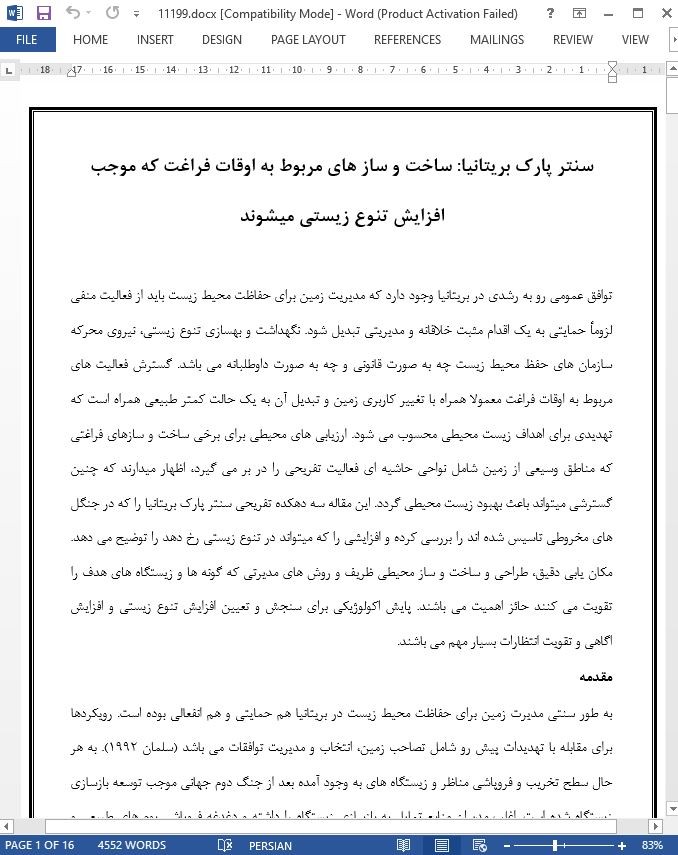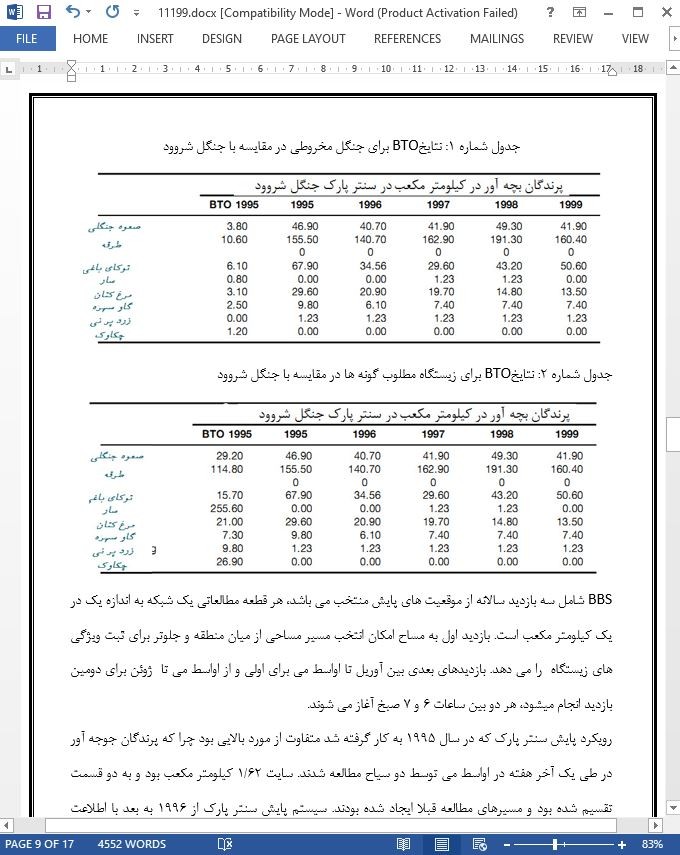
سنتر پارک بریتانیا: توسعه مربوط به اوقات فراغت که موجب افزایش تنوع زیستی میشوند
توافق عمومی رو به رشدی در بریتانیا وجود دارد که مدیریت زمین برای حفاظت محیط زیست باید از فعالیت منفی لزوماً حمایتی به یک اقدام مثبت خلاقانه و مدیریتی تبدیل شود. نگهداشت و بهسازی تنوع زیستی، نیروی محرکه سازمان های حفظ محیط زیست چه به صورت قانونی و چه به صورت داوطلبانه می باشد. گسترش فعالیت های مربوط به اوقات فراغت معمولا همراه با تغییر کاربری زمین و تبدیل آن به یک حالت کمتر طبیعی همراه است که تهدیدی برای اهداف زیست محیطی محسوب می شود. ارزیابی های محیطی برای برخی ساخت و سازهای فراغتی که مناطق وسیعی از زمین شامل نواحی حاشیه ای فعالیت تفریحی را در بر می گیرد، اظهار میدارند که چنین گسترشی میتواند باعث بهبود زیست محیطی گردد. این مقاله سه دهکده تفریحی سنتر پارک بریتانیا را که در جنگل های مخروطی تاسیس شده اند را بررسی کرده و افزایشی را که میتواند در تنوع زیستی رخ دهد را توضیح می دهد. مکان یابی دقیق، طراحی و ساخت و ساز محیطی ظریف و روش های مدیرتی که گونه ها و زیستگاه های هدف را تقویت می کنند حائز اهمیت می باشند. پایش اکولوژیکی برای سنجش و تعیین افزایش تنوع زیستی و افزایش اگاهی و تقویت انتظارات بسیار مهم می باشند.
مقدمه
به طور سنتی مدیرت زمین برای حفاظت محیط زیست در بریتانیا هم حمایتی و هم انفعالی بوده است. رویکردها برای مقابله با تهدیدات پیش رو شامل تصاحب زمین، انتخاب و مدیریت توافقات می باشد (سلمان 1992). به هر حال سطح تخریب و فروپاشی مناظر و زیستگاه های به وجود آمده بعد از جنگ دوم جهانی موجب توسعه بازسازی زیستگاه شده است. اغلب مدیران منابع تمایل به بازسازی زیستگاه را داشته و دغدغه فروپاشی بوم های طبیعی و نیمه طبیعی باقیمانده را دارند. حال این فروپاشی میتواند یا براثر انزوا اتفاق بیفتد یا به علت آسیب پذیری نسسبت به عوامل محیطی. برای مثال راول(1991) تخمین میزند که سالیانه 200 محوطه ویژه علمی (SSSIs) آسیب دیده یا نابود میشوند.
پایش پیوسته اکولوژیکی
هدف اصلی از پایش تغییرات اکولوژیکی فراهم آوردن داده به عنوان اساسی علمی برای حفاظت میحط زیست (اسپلربرگ، 1991) ارزیابی دستاوردهای تنوع زیستی و همچنین رشد آگاهی و انتظارات می باشد. این هدف هم برای کارمندان و هم برای ارباب رجوع مهم می باشد. پایش همچنین زمینه را برای طرح های مدیریتی مکانی با هدف توسعه موثر منابع موجود و بنابراین ابقاء دستاوردهای تنوع زیستی و کمک به سنتر پارک برای تضمین موفقیت تجاری فراهم می کند.
There is a growing consensus that land management for nature conservation in the UK must move from being a negative, essentially protectionist, activity to being a positive, creative, managerial one. Maintaining and enhancing biodiversity is the driving force for both statutory and voluntary nature conservation organisations. Leisure development is often associated with a change of land use to a ‘less natural’ environment, which threatens nature conservation interests. However, this does not have to be the case. Environmental assessments for some leisure developments which involve large areas of land, including areas marginal to the main focus of recreational activity, have suggested, at the planning stage, that such developments can result in environmental improvements. This paper examines the three Center Parcs UK Holiday Villages established in coniferous woodland plantations and illustrates the biodiversity gains, which can be achieved. Careful site selection, environmentally sensitive design and construction, and management regimes that foster target species and habitats are important. Ecological monitoring is vital both to quantify and substantiate biodiversity gains and to raise awareness and confrm expectations.
INTRODUCTION
Traditionally land management for nature conservation in the UK has been both protectionist and reactive. Strategies to deal with perceived threats comprised site acqui- sition, designation and management agree- ments (Selman, 1992). However, the level of landscape and habitat degradation and frag- mentation in the UK, experienced since World War II, has prompted the development of habitat restoration. Many resource man- agers wish to restore habitat because they are concerned that remaining natural and semi-natural habitats are being degraded both by their isolation and their vulnerability to external environmental factors. Rowell (1991), for example, estimated that 200 Sites of Special Scientic Interest (SSSIs) are dam- aged or destroyed every year.
Ongoing ecological monitoring
A key objective of monitoring ecological change is to provide data as a scientifc basis for conservation (Spellerberg, 1991). Quantifying biodiversity gains also raises aware- ness and expectations. This is important for both employees and clients. Monitoring also allows for site-specifc management plans targeted at the effective deployment of avail- able resources and thus sustains biodiversity gains and for Center Parcs helps to guarantee commercial success.
مقدمه
اهمیت تنوع زیستی
کمک گسترش فعالیت های مربوط به اوقات فراغت به اهداف تنوع زیستی
سنتر پارک بریتانیا
دستاوردهای تنوع زیستی
پرندگان جوجه آور جنگل شروود (Sherwood)
تنوع گیاگان (فلور)
گونه های بی مهره
نتیجه گیری
مکان یابی دقیق
طراحی و ساخت محیطی ظریف
سبک های مدیریتی که گونه ها و بوم های هدف را تقویت می کنند
پایش پیوسته اکولوژیکی
INTRODUCTION
THE IMPORTANCE OF BIODIVERSITY
THE CONTRIBUTION OF LEISURE DEVELOPMENTS TO BIODIVERSITY TARGETS
CENTER PARCS UK
BIODIVERSITY GAINS
Sherwood Forest breeding birds
Floristic diversity
Invertebrate species
CONCLUSIONS
Careful site selection
Environmentally sensitive design and construction
Management regimes which foster target species and habitats
Ongoing ecological monitoring
- اصل مقاله انگلیسی با فرمت ورد (word) با قابلیت ویرایش
- ترجمه فارسی مقاله با فرمت ورد (word) با قابلیت ویرایش، بدون آرم سایت ای ترجمه
- ترجمه فارسی مقاله با فرمت pdf، بدون آرم سایت ای ترجمه



